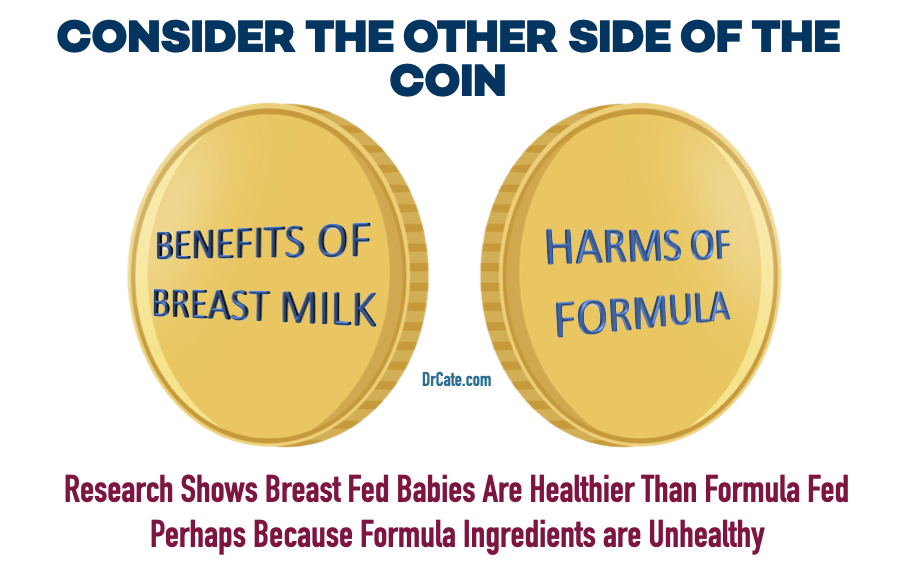More people get asthma as adults than 'grow out' of asthma they had as kids.…

Infant Formula: How and Why to Make Your Own
Table of Contents
- Food is Life
- The studies showing breast milk’s benefits are also revealing formula’s harms
- The unspoken option for women who can’t breastfeed.
- Who Makes Infant Formula?
- Your pediatrician has been programmed to believe formula is better than it actually is.
- Infant Formula Is Processed Food
- Formula Lacks Nearly Half the Necessary Brain Building Fatty Acids
- The Worst Ingredient In Infant Formula
- Powdered Infant Formulas are FULL of Toxins (serious toxins)
- Acrylamide is a Powerful Toxin
- Why Don’t Doctors and Dietitians Understand Any of This?
- What can you do?
- Three Keys to Minimizing Formula’s Toxicity
- DR. KEN BERRY INVITES DR. CATE TO DISCUSS THE CRISIS on YOUTUBE
- Additional Points and References (In addition to links built into the article):
- RECIPE SECTION
I’ve been studying processed food manufacturing for 20 years. I’ve studied who runs these companies. I’ve studied how bad their products are. And I’ve studied how they also prevent doctors and the public from learning the truth.
This article explores the downsides of feeding babies factory formula and will help you make your own, nutritionally superior formula using real food.
I want to be very transparent about my intentions here. My goal is not to shame moms who can’t breastfeed but to inspire parents to make their own formula at home.
What I want to show you in this article is that infant formula is processed food. When your doctor recommends starting your baby on formula rather than making your own, he’s telling you to get your baby started out early on processed food.
If you’d like to jump to the recipes, click here.
This article is continued below...(scroll down)
Food is Life
Babies are precious and fragile. And what you feed your baby can make the difference between life and death. What I’m suggesting is that if you don’t happen to be one of the lucky minority of women (these days it’s a minority) who can exclusively breastfeed, you have another option that’s much better than formula. You can make your own, and if you do it right it will be far more nutritious than regular formula.
A good recipe may even give your child many of the same gifts as breastfeeding.
Why would I make this audacious recommendation?
The studies showing breast milk’s benefits are also revealing formula’s harms
Parents: You deserve to know that there is much more to the story of breast milk’s so-called superiority over formula than you have been told.
Yes, breast milk is amazing. It’s a miraculous mix of life-giving ingredients. Babies fed breast milk benefit from a long list of health advantages over babies fed formula.
I touch on just a few here and you can find more benefits and reference citations here.
Breast Milk Helps Baby’s Immune System
Children who are breastfed for any length of time are 64 percent less likely to develop digestive system infections – an effect that lasts up to two months after breastfeeding stops.
Breastfeeding for three months or longer helps to prevent eczema.
Breastfeeding for six months or longer helps to prevent two different kinds of childhood leukemia.
Breast Milk Helps Baby’s Brain and Learning
Some breastfeeding increases IQ by 3 points. Exclusive breastfeeding increases IQ by 7.5 points. NOTE: Most people’s IQ falls between a narrow range of 85 and 115. A jump of 7.5 puts your child above a huge chunk of people’s children who otherwise would have outperformed yours.
Compared to babies fed any amount of formula or only formula, breastfed babies’ brains were visibly larger due to 20-30 percent more white matter. This was most obvious in parts of the brain associated with language, emotional regulation, and cognition.
Breastfed babies enjoy so many more benefits it could take up the rest of this article.
The reason for pointing out breastmilk’s benefits is not to say that if you don’t breastfeed your baby you’re a terrible mom. It’s to warn you that every study that shows breastmilk has any benefit is not comparing breast milk to homemade formula. It’s comparing breast milk to a powdered, processed, premade formula containing mostly three highly processed ingredients.
That necessarily suggests two possibilities. The one you’ve heard, that breastmilk is best. And the one you probably haven’t heard, which is that something about the ingredients in infant formulas could be highly problematic.

Processed food companies obviously don’t want you, or your Pediatrician, to think about it that way.
The unspoken option for women who can’t breastfeed.
It seems as if you have only two choices when it comes to feeding your baby. Mother’s own breast milk and factory formula. But that is absurd. You can, of course, make your own formula. You just need the right recipe.
My homemade formula recipes are below. I’m writing all this extra stuff to help you understand what a profound difference it could make to your child’s future health and development. Just as breastfeeding is heroic, especially in this day and age, I believe making your own infant formula is also a heroic thing to do.
Dietitians, Please Help!
If you’re a dietitian reading this, please consider how you could use your considerable expertise to ensure that new moms and dads make their homemade formula correctly and safely. Beyond just finding a good recipe, and I have posted three below, there’s a lot to making your own formula! You have to get the ingredients. You have to measure the ingredients. You have to heat some of them. You have to blend them. You have to do it all in a clean and safe way. If you don’t use up each ingredient, you have to know if it can be stored safely until you make another batch. And you have to know about the shelf life of the final formula.
With all this technical know-how involved, parents could certainly use professional help and support.
And yes, you’ll make a much better product by doing it yourself. To drive home that point, which will help you appreciate why it’s worth the trouble to make your own, let’s start by looking at who you’ve been buying from.
Who Makes Infant Formula?
The world’s top ten infant formula manufacturers include brands I’ve known since I was a kid, like Nestle, Abbot, Kraft, and Heinz. I’ve known these brands because they sell a lot of other foods.
The foods these huge companies sell are not farm-fresh ingredients. They are processed foods. And we all know that processed foods are less healthy than foods we make from scratch. In fact, processed food consumption is linked to just about every disease, including the most common metabolic disease, type 2 diabetes. Abbot, conveniently, also sells drugs and medical devices to treat type 2 diabetes and its complications.
So they sell you processed foods that make you unhealthy. Then they sell you drugs to treat the medical conditions that their foods will give you. Abbot’s 2022 fortune 500 rank is 86, Nestle’s was 79 in 2020 and KraftHeinz ranks 139. These guys certainly know what they’re doing when it comes to business.

Your pediatrician has been programmed to believe formula is better than it actually is.
These fortune 500 companies have the means to control the what-to-feed-baby conversation. Nestle has long since discovered how easy it is to influence doctors. Infant formula manufacturers have a rather shady history of doing whatever it takes to get their products sold. I’m going to hone in on just one tactic.
More Perfect than BreastmilkTM
I remember my mother telling me that her mother was actively discouraged from breastfeeding by both her gynecologist and the pediatrician.
Back in the 1940s, you needed a doctor’s prescription to get infant formula, and doctors who wanted to seem cutting edge were telling women to bind their breasts and use formula instead. The tagline that the pharmaceutical companies selling them the formula gave doctors so that they could turn around and sell the formula to new mothers was the claim that their expensive (compared to free) formula was “More perfect than breast milk.”
As a result, doctors who wanted to seem upscale sold formula to their wealthier clients. It wasn’t hard to get doctors on board back then. After all, that was the better-living-through-chemistry era.
How far have doctors evolved since then? Well, now we realize how arrogant and wrong we were about breastmilk. We know that it contains essential fats that nobody added to formula back in the 1940s, stem cells, immune cells, and over 200 kinds of carbohydrates including probiotics, nucleotides, and antibodies—and that’s just getting started. Breast milk is truly a miracle. And my mom and dad, along with millions of baby boomers, were denied that miracle.
But in spite of our increased ability to understand what makes breast milk so amazing, we’re still doing a huge disservice to women who can’t breastfeed.
Some Formulas Have Useful Additives
The infant formulas doctors recommend today are a little bit more sophisticated than they used to be. They contain a more complete set of vitamins and minerals (that you could get from any decent infant multi). And some formulas contain human milk oligosaccharides found in breast milk that are important for baby’s digestive system. (But just one type. Breast milk contains over a hundred.) Some formulas have a few other additives of note, like nucleotides.
But the unspoken reality is that 98% of the volume of most infant formulas comes from just three of the world’s cheapest ingredients. These ingredients are everywhere. There’s nothing special or healthy about them. We buy one or all of them whenever we buy candy, chips, or other snacks at the local 7 Eleven. We certainly don’t consider them healthy when we buy them at a gas station convenience store. Why would they be healthy when we put them into a canister?
Infant Formula Is Processed Food
The main ingredients in infant formula are the same three ingredients in ultra-processed food. They are:
- Some kind of refined carbohydrate, like sugar
- Some kind of protein powder, like whey protein powder or soy protein concentrate
- Some kind of seed oil, like corn, soy, or canola.
Number three is the worst of the bunch.
When it comes to feeding gown ups, nobody in their right mind would believe sugar is healthy. Nor would they accept the idea that a Coffee Crisp bar, a popular candy bar, is healthy. But look at the top three ingredients and you’ll see it’s exactly what you’d expect from looking at the list above.

These three ingredients show up as the main ingredients in processed food all the time. In fact, if you don’t make all your food from scratch, you’re probably getting more than half of your calories from the same three kinds of ingredients that formula is made from.
That’s why it’s a bit of an embarrassment to the profession that women who can’t breastfeed are given only two choices. The incredibly miraculous substance known as breast milk OR the worst of the worst kinds of processed food ingredients.


When your doctor or anyone else advises against making your own infant formula, they’re sending you straight to the companies that make junk foods. Everyone agrees that junk food is bad for us and makes us sick. I think moms deserve to know about alternatives to infant formula that are free of junk-food ingredients.
Infant Formula is Made By Companies That Sell Processed Food
I’m going to dive into what we know about infant formula’s toxicity next. Here, I want to briefly point out what other products the top infant formula companies sell.

Kraft Heinz is a tiny bit better because they actually sell some food. But chances are they make most of their money from the processed food brands that include Cool Whip, Cheez Whiz, Jet-Puffed, Kool-Aid, Velveeta, and Polly-o.
Abbot may be the most Orwellian, given that they sell the foods that cause diabetes and other diseases and make the drugs that diabetics take and much of the medical equipment diabetics will need to treat their disease and its complications.
Formula Lacks Nearly Half the Necessary Brain Building Fatty Acids
The most important fatty acids for a baby’s brain are called essential fatty acids. They are “essential” because our bodies can’t make them. For your baby to get enough material for his growing brain, his diet needs these fatty acids.
Not a huge amount, maybe a total of a gram (1/30th of an ounce). This gram ideally will contain an equal balance of the two major categories of fatty acids, omega-3, and omega-6. Indeed, historical records suggest that a human diet was nearly perfectly balanced in these two categories, with roughly a 1:1 ratio of each in the diet. Therefore, that’s logically the best guess at what breastmilk should contain.
But infant formula is not balanced like that. It’s balanced based on an average woman’s average diet, which is adequate in omega-3 but way too high in omega-6. This translates to a formula that is way too low in omega-3 and about twice what a baby really needs in terms of omega-6.
This article shows that some very smart people are promoting a very unhealthy ratio of fatty acids. Why would they do that? Our nutrition science is very problematic. It ignores all of history based on the idea that “we’re living longer now” because people of the past ate “wrong.” When nutrition science ignores what people ate before the industrial era, it ignores the best resource we have for defining a healthy diet.
In other words, nutrition experts tend to overlook the differences between our historical versus our current average person’s diet. This has been very bad for our health, as I explain in my first book Deep Nutrition: Why Your Genes Need Traditional Food.
Why Formula is Deficient in Omega-3
As I mentioned, the formula is formulated based on the average person’s diet becuase of the assumption that the average person’s diet is healthy. And the average person eats about 10 times more omega-6 than omega-3. But the average person’s diet is not healthy. If it were we would not have an obesity and diabetes epidemic.
Why would the average person’s average diet be so imbalanced?
That’s what I’ve been studying for 20-plus years. The simple answer is that we sell people what we can easily grow in our climate. There’s so much more to this story that it would fill a book. That’s why I have covered different aspects of this problem in each of my books.
The Worst Ingredient In Infant Formula
Now, let’s get into what makes most infant formulas so horribly unhealthy—starting with something you might dismiss as fear-mongering if you have never heard it before. Seed oils used as the main fat source in these formulas should not be considered food. They are factory-made products that contain numerous toxins due to the harsh processing that chemically alters the fatty acids in seed oils.
But it’s not just my claim. The world’s top scientists who are the experts in the topic of oil chemistry have been making this claim for a very long time.

What I’m going to be doing next is showing you the critically important stuff that seed oil scientists have been trying to warn us about for decades. And the scary part is what I’m going to tell you is, that even though most of this has been accepted by scientists for over 40 years, it’s still not taught in medical school. Dietitians do not learn about any of this in their training, either. The only reason I have a clue is that I studied organic chemistry and biochemistry at Cornell before getting my MD.
Powdered Infant Formulas are FULL of Toxins (serious toxins)
I’m not talking about theoretical toxins like what broccoli contains that could theoretically lead to cancer if you ate unachievable volumes of it. I’m talking about chemicals like acetaldehyde and acrolein. These are the kinds of compounds that make cigarettes and varnish unhealthy.
The WHO lists both acetaldehyde and acrolein as potential or known carcinogens that also have cell-killing and inflammation-causing properties. And according to the math I did, the amounts found in infant formula can exceed the WHO (World Health Organization) acceptable limits.

These toxins are not the typical type of toxins we hear about. They have nothing to do with GMOs or pesticides, herbicides, and heavy metals. Indeed, those all present problems, but are far less significant than the toxins that I’m talking about.
Infant formula toxins develop during the processing and storage steps involved in making infant formula, especially powdered formula. Researchers warn “Analysis of market samples demonstrated that all selected brands of powder infant formula were remarkably contaminated with acrylamide.”
Acrylamide is a Powerful Toxin
Acrylamide is so toxic it’s earned a spot on the National Toxiciology Program’s exclusive list of agents reasonably expected to cause cancer. Nothing in broccoli, or dairy, or eggs or any real food is on this list. Red meat is not supposed to be on the list unless it’s burnt to a char or saturated in nitrates.
Acrylamide is not just a cancer-causing agent. It’s also known to have toxicity to the nervous and reproductive systems. This is from the CDC. So doctors and dietitians and anyone promoting formula may want to have a look.
Most other processed foods made with seed oils will contain this toxin. It is very likely contributing to the high rates of learning disorders among today’s children. I also believe it may be playing a role in causing medical (versus social) gender dysphoria, since it interferes with sexual development.
The Dose Makes The Poison
People who study toxicology frequently remind us that “The dose makes the poison.” The amount of acrylamide in infant formulas matters. If it’s just a tiny bit, it’s not that bad. If it’s a lot, that’s really bad.

So, how much acrylamide is there?
Well, it depends. If you do the analysis as it comes out of the factories, there’s some but not enough to exceed recommended thresholds. But if you do the analysis after it’s sat on the shelf long enough to react with the “headspace oxygen” there’s quite a bit.
According to the article, infant formulas contain significant doses of acrylamide, as much as 5.8 micrograms of acrylamide per gram of formula. Doing a little math, I calculated that children exclusively fed formula may be exposed to 100-500x the upper limit of acrylamide. Acrylamide
How Bad Is That Much Acrylamide?
Acrylamide is a triple threat toxin, according to the CDC.
It’s a probable carcinogen. Perhaps this contributes to the previously mentioned greater risk of leukemia in formula-fed infants. It’s also a neurotoxin. Perhaps this may help to explain why infants who are exclusively formula-fed experience the aforementioned brain size reductions and learning difficulties. Acrylamide is also pro-inflammatory, toxic to the gut, and breeds harmful gut flora. Perhaps this is why formula-fed babies experience more food and other allergies, eczema, and autoimmune disorders.
Formula Also Contains a Multitude of OTHER Toxins
Acrylamide is just one kind of toxin found in formula. There are many more.
Here’s a quote “Maillard reaction between [formula’s main ingredients], not only can alter the color and flavor of infant formulas, but also lowers the nutritional value of protein, damages vitamins and even produces anti-nutrients and toxic substances, thereby influencing the stability of their shelf life.” [Quote translated from this article]
And worse, after you open it, the toxic formation accelerates dramatically. That’s why all formula containers warn that you need to throw away any unused portion after 30 days.
Why Don’t Doctors and Dietitians Understand Any of This?
We have a real knowledge gap in the halls of academic medicine. Doctors and dietitians don’t read the kinds of journals where oil scientists can get their work published. So in spite of having hundreds of articles available to them, most of these health professionals mistakenly believe that the claims I’m making here are not backed by research because they don’t ever get to see the research.
And if they try to read it, since it’s full of technical jargon, most MDs and RDs can’t really understand it anyway.
What can you do?
For one thing, as you feed your baby formula, perhaps feeling lucky you got your hands on some during this shortage, perhaps wishing you could breastfeed, you can consider this. As I mentioned above, if powdered formulas are full of toxins, then the reason studies show that breastfed babies do so much better in so many aspects of life is that babies fed powdered formula are being fed toxins. It’s shameful.
And the shame is on them, not you.
So here’s my thinking. If you can’t use human milk, try to use another mammal’s milk. And then let’s modify that with high-quality ingredients to make it as close to mother’s milk as possible.
Fresh milk is going to be better than soy or whey protein powder. I’ve focused so far on the toxicity of seed oils, but protein powders are highly toxic too, especially when mixed with sugar as they are in infant formulas and candy bars.
Three Keys to Minimizing Formula’s Toxicity
If you have no choice other than powdered infant formula, there are a few steps you can take to reduce your baby’s exposure to toxins.
First, look at the expiration date and chose a container with a date that is as far in the future as possible. This is because as it sits on the shelf, toxins are developing. The longer it sits, the more toxins you’ll be feeding your baby. The fresher the batch, the better.
Second, store the powder in your fridge before and after opening. This is because the detrimental reactions that cause toxins to form are accelerated by heat. The colder you keep the powder, the fewer toxins form.
Third, be sure to write the date you open it so you can keep track. Most infant formula canisters say to throw it away 30 days after opening. This is because once you open it, the oxygen from the air mixes with the seed oil, the sugars, and the protein powders and rapidly generates a whole ton of new toxins. This is perhaps the most important step of the three.
Hopefully Encouraging Words
If, after you read and digest the implications of this article you decide you want to try to do better for your child than premade powdered formula, I’ve got some recipes for you. If you are able to devote a little time and energy to learning how then your time will be rewarded in spades. Not just in real actual hours visiting doctors you will save. But also in ways that are less tangible but more valuable.
Let’s face it, everything in life is highly competitive and getting more competitive every day. What’s the price tag for knowing you’ve given your child an edge on the competition?
RELATED ARTICLES
For a Primer on Deep Nutrition principles, visit:
DR. KEN BERRY INVITES DR. CATE TO DISCUSS THE CRISIS on YOUTUBE
Additional Points and References (In addition to links built into the article):
Storage generates a dizzying variety of new toxic compounds. Title: “Infant Milk Formulas: Effect of Storage Conditions on the Stability of Powdered Products towards Autoxidation” [link]
Bigger kids get massive doses of acrylamide. Title: “Risk Evaluation of Acrylamide in Powder Infant Formula Based on Ingredient and Formulation in Three Critical Age Groups of Children Below 2 Years Old: Efficient Microextraction Followed by GC–MS Analysis Based on CCD” [link]
Consuming oils in powdered form is not a good idea. Spray drying oxidizes PUFA. “Spray-Dried Structured Lipid ContainingLong-Chain Polyunsaturated Fatty Acids for Use in Infant Formulas” [link]
RECIPE SECTION
Here’s my favorite formula recipe:
MILK, CREAM, And COLLAGEN BASED FORMULA
(Also the simplest)
prep 15 mins total 15 mins
Modified from https://drjockers.com/homemade-baby-formula/
yield 34 ounces
Ingredients*:
- 2 cups of filtered water
- 2 tsp collagen protein
- 4 tbsp. lactose
- 2 cups whole milk, ideally pasture-raised cow or goat milk
- 4 tbsp. heavy cream (ideally pasture-raised) OR 1.5 TBSP pasture butter
- 1 capsule contents Lacto (optional, for lactose digestion support)
- ¼ teaspoon of infant probiotics (keep in the fridge to keep them alive)
- 2 teaspoons nutritional yeast flakes
- 1/2 tsp or 2 x1000mg capsules (punctured to express oil) high-quality fish oil (look for these terms: molecularly distilled or Supercritical Extraction with CO2 to prevent oxidation, example brand))
- 1 teaspoon unrefined hemp oil (for more omega 3 and vitamin E)
- 1 teaspoon extra virgin olive oil
- 2 teaspoons coconut oil (for medium-chain fatty acids)
INSTRUCTIONS
*This recipe has been adapted from the Weston A Price Foundation. Please visit their site for many answers to your homemade baby formula questions!
Instructions:
Step #1 Take 2 cups of filtered water pour about half the water into a pan and turn the heat on medium.
Step #2 Add 2 teaspoons of collagen protein and 4 tablespoons lactose to the warming water and let dissolve, stirring occasionally.
Step #3 While the collagen and lactose are dissolving, place 2 cups of raw whole milk in a clean, glass blender and add the remaining ingredients:
- Cream or Butter (per amounts above)
- ¼ teaspoon of bifidobacterium infantis
- 2 teaspoons nutritional yeast flakes
- 1/2 tsp or 2 x1000mg capsules (punctured to express oil) high-quality fish oil
- 1 teaspoon extra virgin olive oil
Step #4 Then remove the pan from the heat and pour in the remaining half of the water to cool.
Step #5 Next, add 2 teaspoons coconut oil and (optional) ¼ teaspoon butter oil to the water to melt.
Step #6 Add the water mixture to the blender ingredients and blend for about 3 seconds.
Step #7 Pour the blended ingredients into glass jars and refrigerate.
ALSO USE: THIS IS VERY IMPORTANT
USE DAILY: Pediatric vitamins. For example, PolyVISol vitamin drops with D (and without iron for better digestive health).
Milk and CREAM based Formula
Modified from WAPF foundation with my notes in italics
This milk-based formula takes account of the fact that human milk is richer in whey proteins, lactose, vitamin C, niacin, and long-chain polyunsaturated fatty acids compared to cow’s milk but leaner in casein proteins. (I don’t think that’s terrifically important and I bring this up becuase whey is hard to get except in a powdered form which I never recommend.) The addition of gelatin or collage to cow’s milk formula will make it more digestible for the infant.
The WAFP website includes whey but I list it as optional. I did this becuase whey is so hard to get except in powdered form (which I never recommend.) And it’s unclear that the whey to casein ratio matters very much.
Use only unrefined oils in the formula recipes, otherwise, they may lack vitamin E.
According to the WAPF foundation “The ideal milk for baby, if he cannot be breastfed, is clean, whole raw milk.”
This is a big reason I needed to modify the WAPF recipe!
Finding raw milk is difficult and feeding raw milk to infants seems like a bad idea, especially if the infant was previously fed a powdered formula. Those formulas assault the gut with toxins, breeding pathogenic bacteria and weakening their immune systems. (More on this below).
I recommend getting pasteurized milk. It’s best from cows that feed on green pasture and will be labeled “grass milk” or “pasture milk.” If you want to use goat milk instead, that’s also great. Most people selling goat milk raise goats on a species-appropriate diet.
Note Pasture and Pasteurized are completely different things. If possible, milk that is organic and unhomogenized is also wonderful.
- 2 cups whole milk, ideally pasture-fed cow or goat milk
- 1/4 cup Optional liquid whey (not powdered). The only way to get it is to make your own or order from a specialty shop. That’s why it’s optional.
- 2 Tbsp grass milk cream
- 0.5 tsp or 2 x1000mg capsules (punctured to express oil) high-quality fish oil (look for these terms: molecularly distilled or Supercritical Extraction with CO2 to prevent oxidation, example brand)
- 1/4 tsp high vitamin butter oil or grass-fed brand of butter (Armor, Organic Valley Pasture Butter, Kerrygold)
- 1 tsp cold-pressed, unrefined hemp oil (Manitoba harvest, Nutiva)
- 1 tsp EVOO
- 2 tsp coconut oil
- 2 tsp nutritional yeast
- 1 gm inisotol
- 1.5 tsp sugar or better Lactose
- 1 Tbsp Maltodextrin
- 1 TBSP dehydrated liver powder or preferably 1-ounce liver, steamed.
- 1-7/8 cups water
- 2 tsp gelatin or CB supplement powder
INSTRUCTIONS
- Put 2 cups filtered water into a pyrex measuring pitcher and remove 2 tablespoons (that will give you 1-7/8 cups water).
- Pour about half of the water into a pan and place on a medium flame.
- Add the gelatin or collagen powder and lactose to the pan and let dissolve, stirring occasionally.
- When the gelatin and lactose are dissolved, remove from heat and add the remaining water to cool the mixture.
- Stir in the coconut oil and optional high-vitamin butter oil or grass fed butter, and stir until melted.
- Meanwhile, place remaining ingredients into a blender.
- Add the water mixture and blend about three seconds.
- Place in glass bottles or a glass jar and refrigerate.
- Before giving to baby, warm bottles by placing in hot water or a bottle warmer. NEVER warm bottles in a microwave oven.
ALSO USE: THIS IS VERY IMPORTANT
USE DAILY: Pediatric vitamins. For example, PolyVISol vitamin drops with D (and without iron for better digestive health).
LIVER BASED FORMULA [modified from WAP]
Makes about 36 ounces.
This liver-based formula also mimics the nutrient profile of mother’s milk. Coconut oil provides the special medium-chain saturated fats found in mother’s milk and all dairy fat from animals fed a species-appropriate diet. As with the milk-based formula, all oils should be unrefined.
As with the milk-based formula, the WAFP website includes whey but I list it as optional. I did this becuase whey is so hard to get except in powdered form (which I never recommend.) And it’s unclear that the whey to casein ratio matters very much.
INGREDIENTS
- 3-3/4 cups homemade beef or chicken broth
- 2 ounces organic liver, cut into small pieces
- 5 tablespoons lactose
- 1/4 teaspoon bifidobacterium infantis (example brand)
- 1/4 OPTIONAL cup homemade liquid whey (See recipe for whey, here)
- 1 tablespoon coconut oil
0.5 tsp or 2 x1000mg capsules (punctured to express oil) high quality fish oil (look for these terms: molecularly distilled or Supercritical Extraction with CO2 to prevent oxidation, example brand)
- 1 teaspoon unrefined flax oil
- 2 teaspoons unrefined extra virgin olive oil
INSTRUCTIONS
Simmer liver gently in broth until the meat is cooked through.
- Liquefy using a handheld blender or in a food processor.
- When the liver broth has cooled, stir in remaining ingredients.
- Store in a very clean glass or stainless steel container.
- To serve, stir formula well and pour 6 to 8 ounces in a very clean glass bottle.
- Attach a clean nipple and set in a pan of simmering water until formula is warm but not hot to the touch, shake well and feed to baby. (Never heat formula in a microwave oven!)
ALSO USE: THIS IS VERY IMPORTANT
USE DAILY: Pediatric vitamins. For example, PolyVISol vitamin drops with D (and without iron for better digestive health).
Please note: Please do not share personal medical information in a comment on our posts. It will be deleted due to HIPAA regulations.
This Post Has 9 Comments
Note: Please do not share personal information with a medical question in our comment section. Comments containing this content will be deleted due to HIPAA regulations.



















Hi Dr. Cate! I listened to your book “Dark Calories” and have heard you speak on a few podcasts. I’m so thankful for the information you’ve shared!! My little one is 7weeks old and has had a hard time gaining weight d/t congenital heart defect. He needs to gain weight heart surgery and the pediatrician gave me powdered formula with the plan to pump breast milk and add powdered formula to make it more caloric. It’s worked well but I’d very much prefer to switch off the vegetable oils. Would you recommend adding something different to my breastmilk to make it more caloric? Also, is the liver formula recipe for all ages? Thank you for any help you can give! I love your work and have been recommending your latest book to all my family and friends!
Hi Jennifer,
Supplementing breast milk makes sense to me. Definitely would be important to get the highest quality. The liver formula does work for all ages. More information from The Weston A Price Foundation and https://wellnessmama.com/motherhood/baby-formula-options/
Thank you so much for sharing my work and my heart goes out to you and your little one, best wishes for you!
What do you think of byheart formula?
I don’t love it, sorry to say.
Hi. Are seed oils needed for homemade formula? I make wapf but they recommend sunflower oil which I thought was toxic.
Essential fatty acids are necessary. High quality sunflower oil could be made in a way that does not generate toxins, however other sources of essential fatty acids are probably safer.
Wondering about storage and shelf life of homemade formulas? Can it be prepared and frozen in batches? If so, for how long (one month at a time)? If not, how ofter does it need to be prepared? daily? Thank you
There is not a lot of research in this area and preparation rates depend on usage rates, which will vary as your baby grows. I would treat it like any other highly perishable food. Frozen would last several months. Freeze if you make more than a few days supply at a time.
This is great information, thank you. I ordered the ingredients to make the milk cream and collagen-based formula. I have a baby due any day now and I want to have a better backup than the factory-made formula if breastfeeding is unsuccessful.
Now I’m just having a hard time convincing my wife it is a good idea. She believes all the articles telling people it is a bad idea to make your own formula. Wish me luck!